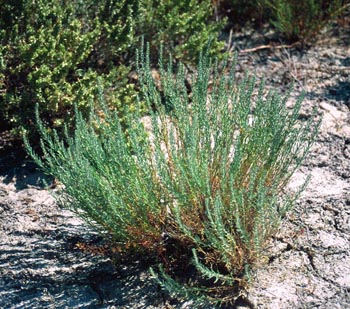Greenmolly

Common Name(s):
Greenmolly
Green Molly
Desert Molly
Greenmolly Summercypress
Red Sage
Gray Molly
Scientific Name:
Bassia americana (S. Watson) A.J. Scott
Scientific Name Synonyms:
Kochia americana S. Wats.
another synonym goes here
Symbol:
KOAM
Description:
Life Span: Perennial
Origin: Native
Season: Deciduous
Growth Characteristics: A 4 to 16 inch subshrub, woody and much branched at the base, simple and herbaceous above. Stems are grayish-white. Flowers in late summer, reproduces from seeds.
Flowers/Inflorescence: Flowers are small, without stalks, extremely hairy and white.
Fruits/Seeds: Fruit is a utricle.
Leaves: Alternate or opposite, often occurring in fascicles (similar to a pine tree). The blades are narrow, fleshy, and about ½ inch long. Surfaces are dark green and covered with long silky hairs.
Stems: Grayish and hairy.
Ecological Adaptions:
Occurs in desert valleys, flats, marshes, roadsides, and foothills of the cold desert region. New growth, especially the leaves, often dries to a black color.
Soils: Saline, sandy clay loams.
Associated Species: Saltbush, shadscale, black sagebrush, Indian ricegrass, saltgrass.
Uses and Management:
Greenmolly provides excellent forage for sheep, cattle, and deer. It is often used as winter forage for sheep. It is high in protein during the fall. There is some evidence that it may accumulate nitrates.

